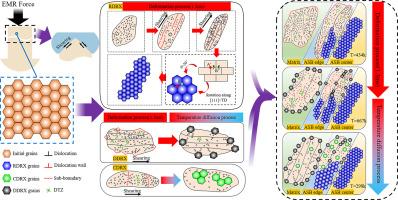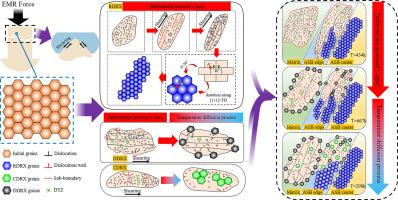Multiple recrystallization mechanisms of adiabatic shear bands: Observations via electromagnetic force-induced wide-range transition zones
IF 12.8
1区 材料科学
Q1 ENGINEERING, MECHANICAL
引用次数: 0
Abstract
Over the past decades, the formation mechanisms of adiabatic shear bands under dynamic loading have attracted wide coverage from researchers. This study introduces a novel approach focusing on the transition zones at ASB edge rather than their fully recrystallized center to advance current understanding. These regions can be regarded as transitional stages within the unaccomplished dynamic recrystallization process, thereby demonstrating the accurate evolution. Using electromagnetic riveting processing of commercial 2A10 Al-Cu alloy, we generated ASB (>130 μm) with distinguishable edge regions exceeding 10 μm in width. Through microstructure characterization under focused ion beam and kinetic analysis, the direct microscopic evidence of rotational dynamic recrystallization and additional recrystallization mechanisms activated alongside rotational dynamic recrystallization were discovered. The results demonstrate the sequential mechanisms: rotational dynamic recrystallization initiates firstly during deformation, producing ultrafine grains at ASB centers; discontinuous dynamic recrystallization subsequently emerges with localized temperature elevation; continuous dynamic recrystallization requires a longer duration than the deformation process itself, classified as incomplete recrystallization.


绝热剪切带的多种再结晶机制:电磁力诱导大范围过渡区的观察
近几十年来,动态加载下绝热剪切带的形成机制引起了研究人员的广泛关注。本研究引入了一种新颖的方法,专注于ASB边缘的过渡区,而不是其完全再结晶的中心,以推进现有的理解。这些区域可视为未完成动态再结晶过程中的过渡阶段,从而显示了准确的演变过程。采用电磁铆接工艺对商用2A10铝铜合金进行加工,生成了宽度超过10 μm的边缘区域可区分的ASB (>130 μm)。通过聚焦离子束下的微观结构表征和动力学分析,发现了旋转动态再结晶的直接微观证据和伴随旋转动态再结晶激活的附加再结晶机制。结果表明:变形过程中首先发生旋转动态再结晶,在ASB中心形成超细晶粒;局部温度升高后,出现不连续动态再结晶;连续动态再结晶需要比变形过程本身更长的持续时间,属于不完全再结晶。
本文章由计算机程序翻译,如有差异,请以英文原文为准。
求助全文
约1分钟内获得全文
求助全文
来源期刊

International Journal of Plasticity
工程技术-材料科学:综合
CiteScore
15.30
自引率
26.50%
发文量
256
审稿时长
46 days
期刊介绍:
International Journal of Plasticity aims to present original research encompassing all facets of plastic deformation, damage, and fracture behavior in both isotropic and anisotropic solids. This includes exploring the thermodynamics of plasticity and fracture, continuum theory, and macroscopic as well as microscopic phenomena.
Topics of interest span the plastic behavior of single crystals and polycrystalline metals, ceramics, rocks, soils, composites, nanocrystalline and microelectronics materials, shape memory alloys, ferroelectric ceramics, thin films, and polymers. Additionally, the journal covers plasticity aspects of failure and fracture mechanics. Contributions involving significant experimental, numerical, or theoretical advancements that enhance the understanding of the plastic behavior of solids are particularly valued. Papers addressing the modeling of finite nonlinear elastic deformation, bearing similarities to the modeling of plastic deformation, are also welcomed.
 求助内容:
求助内容: 应助结果提醒方式:
应助结果提醒方式:


